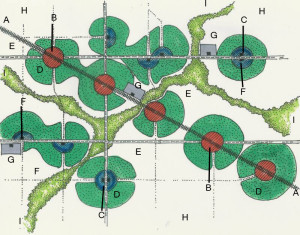Transit-Oriented Development / TOD
Basic Components for the TOD
A Trunk Line – (Rail or Express Bus)
B Urban TOD
C TND – Neighborhood TOD
D Secondary Area
E Existing Uses
F Transit Stop
G Park and Ride
H Other Uses
I Open Space (Environmentally Sensitive)
Transit-Oriented Development with TND Pods
The backbone for the TOD is the Regional Transit System (RTS). Along that path are moderate and high density housing together with complementary public uses, places of employment, and supporting retail and other services. These elements are concentrated in mixed-use developments at strategic points along the RTS. The concentrated elements are also known as; Urban Villages, Traditional Neighborhood Developments, Pedestrian Pockets and Compact Communities. They are all designed with Traditional Neighborhood Design (TND) design principals. A separate discussion on TND can be found on the TND page under Sustainability.
The purpose of the RTS is to significantly reduce the use of individual vehicles, less traffic producing less pollution and less of a demand for roadways and their related maintenance. Mass Transit, perhaps based on electrical energy or the low cost production and use of hydrogen energy, is crucial in the solution to the problem created by the alarming Carbon Footprint we each produce daily. Also reference “The End of Suburbia – Oil Depletion and the Collapse of The American Dream.”. www.endofsuburbia.com
TOD’s Purpose
The purpose of TOD is to establish Urban Growth Boundaries. This intent involves an integrated strategy for growth in our cities, suburbs and towns. The TOD and its regional approach helps guide the definition of meaningful edge for a metropolitan area. Effectively implementing TOD can eliminate random growth.
TOD’s are shaped by three general principals:
- Growth guided by expansion of transit and more compact urban form
- Discard single zoning uses and replace with mixed-use, walkable neighborhoods
- Urban design policies should create a built environment oriented toward the public square and human scale rather than private ownership and vehicular domination
The principals of Transit-Oriented Development are to:
- Use Regional Transit to organize compact growth at a regional level
- Use Transit Stops to allow for commercial, housing, jobs, parks and civic uses to be within walking distances
- Allow local destinations to directly connect via a pedestrian-friendly street network
- Let there be a mix of housing densities, types and costs
- Protect important sensitive habitats and high quality open space
- Let the focus of building orientation and neighborhood activity be the public square
- Allow for reconfiguration of existing neighborhoods with infill and redevelopment along transit corridors
For additional information: The Next American Metropolis by
Peter Calthorpe, TOD website, TOD books


